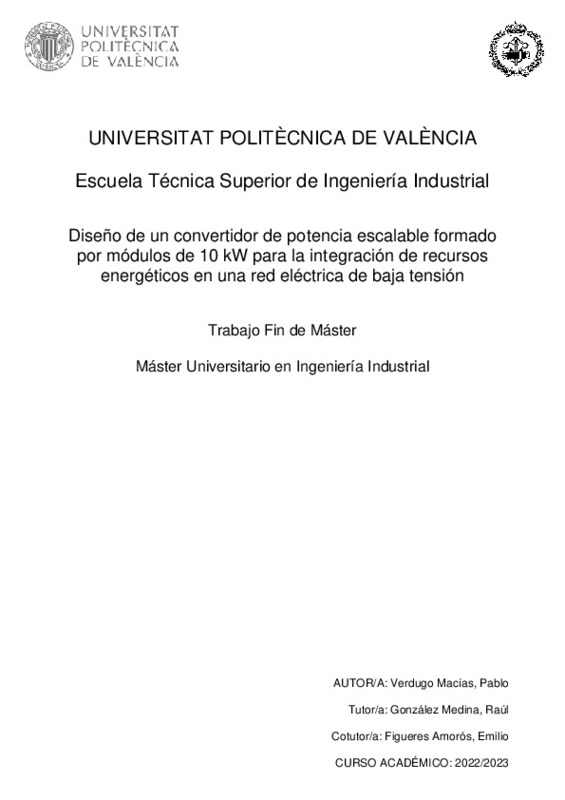|
Resumen:
|
[ES] La potencia solar fotovoltaica instalada en España desde el año 2019 ha tenido un nuevo impulso gracias a las instalaciones de autoconsumo. En este tipo de instalaciones, para potencias inferiores a 100kW es posible ...[+]
[ES] La potencia solar fotovoltaica instalada en España desde el año 2019 ha tenido un nuevo impulso gracias a las instalaciones de autoconsumo. En este tipo de instalaciones, para potencias inferiores a 100kW es posible acogerse al mecanismo de compensación simplificada de excedentes, tal como regula el RD 244/2019. También puede resultar interesante combinar la producción fotovoltaica con baterías para almacenar el exceso de energía y utilizarlo en otro momento, en lugar de verterlo a la red. En el presente Trabajo Final de Master (TFM), se pretende desarrollar un convertidor de potencia modular para interconectar varios recursos energéticos (inversores fotovoltaicos y baterías, aunque podrían conectarse también otros recursos) con una red eléctrica. El convertidor completo estaría formado por dos o más módulos iguales de 10 kW, conectados entre sí por un bus DC común. Los módulos estarán formados por un puente completo de transistores IGBT y un microcontrolador en el que se ejecutarán los lazos de control primario. Cada módulo se podrá utilizar como un inversor monofásico, como dos convertidores DC/DC bidireccionales independientes o un convertidor DC/DC bidireccional de dos ramas funcionando en modo phase-shifting. Sería posible asociar tres módulos para la conexión del convertidor a una red trifásica. Los lazos de control secundarios para gestionar los flujos de potencia entre módulos se ejecutarán en un controlador central que se comunicará con los módulos mediante un bus de comunicaciones UART. El controlador central también se utilizará para la configuración de los módulos en cada aplicación. Se diseñarán la etapa de potencia y de control del módulo de 10kW. El diseño se validará mediante la simulación en PSIM de todos los modos de funcionamiento.
[-]
[EN] The photovoltaic solar power installed in Spain since 2019 has had a new boost thanks to self-consumption facilities. In these types of facilities, for powers of less than 100kW it is possible to take advantage of the ...[+]
[EN] The photovoltaic solar power installed in Spain since 2019 has had a new boost thanks to self-consumption facilities. In these types of facilities, for powers of less than 100kW it is possible to take advantage of the simplified surplus compensation mechanism, as regulated by RD 244/2019. It may also be interesting to combine photovoltaic production with batteries to store excess energy and use it at another time, instead of pouring it into the network. In this Final Master's Project (TFM), it is intended to develop a modular power converter to interconnect various energy resources (photovoltaic inverters and batteries, although other resources could also be connected) with an electrical network. The complete converter would be made up of two or more equal 10 kW modules, connected to each other by a common DC bus. The modules will consist of a full bridge of IGBT transistors and a microcontroller in which the primary control loops will be executed. Each module can be used as a single-phase inverter, as two independent bidirectional DC/DC converters or a two-branch bidirectional DC/DC converter operating in phase-shifting mode. It would be possible to associate three modules to connect the converter to a three-phase network. The secondary control loops to manage the power flows between modules will be executed in a central controller that will communicate with the modules through a UART communication bus. The central controller will also be used for the configuration of the modules in each application. The power and control stage of the 10kW module will be designed. The design will be validated by means of the simulation in PSIM of all the modes of operation.
[-]
|







